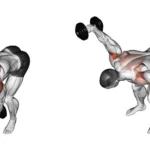Front Squat: Exercise Overview
The front squat is a powerful compound exercise and a key variation of the squat, primarily targeting the quadriceps while also engaging the glutes, hamstrings, core, and upper back. By placing the barbell across the front of the shoulders, this movement emphasizes the quads and demands a more upright torso compared to other squat variations, enhancing lower-body strength and stability. As a foundational movement pattern, the squat is essential for functional fitness and should be a lifelong practice for those physically capable. Finding a squat variation that suits your body mechanics is crucial for safe and effective training (Escamilla et al., 2001). The front squat is an excellent addition to leg-focused workouts, lower-body sessions, or full-body routines, supporting both aesthetic and performance goals (Schoenfeld, 2010).
How to Perform the Front Squat
- Set the barbell on a rack just below shoulder height and position the safety pins at approximately waist level.
- Step under the bar, placing it across the front of your shoulders (on the deltoids), gripping it with hands just outside shoulder-width and elbows raised high to secure the bar.
- Inhale deeply, brace your core, and unrack the bar by extending your knees and pushing your hips forward.
- Take 2–3 steps back, positioning your feet slightly inside shoulder-width, toes angled comfortably.
- Lower your body by bending your knees and pushing your hips back, keeping your torso upright and elbows elevated, until your thighs are parallel to the floor or slightly below.
- Drive through your entire foot to reverse the movement, extending your hips and knees to return to the starting position.
- Exhale at the top and repeat for the desired number of repetitions.
Tips for Optimal Performance
- Experiment with Toe Angle: Adjust your toe angle (neutral or slightly outward) to find the stance that feels most natural and supports your knee alignment (Wirth et al., 2016).
- Use a Comfortable Grip: If the front rack position strains your wrists, use a two- or three-finger grip or switch to a cross-arm grip to maintain comfort and stability.
- Keep Elbows High: Drive your elbows upward throughout the squat to keep the bar secure and maintain an upright torso, reducing forward lean (Escamilla et al., 2001).
- Engage Your Core: Brace your abdominal muscles to stabilize your spine and prevent excessive lower-back arching, enhancing safety (McGill, 2010).
- Drive Through the Whole Foot: Maintain three points of contact (big toe, little toe, heel) to distribute force evenly and engage both quads and glutes effectively.
- Allow Controlled Knee Movement: Some forward knee travel over the toes is acceptable, especially for those with longer femurs, but avoid excessive inward or outward deviation.
- Adjust Neck Position: Test a neutral neck (chin tucked) or slightly forward gaze to find what best suits your posture and comfort (Wirth et al., 2016).
- Breathe Properly: Inhale before descending and exhale as you rise to support core stability and muscle oxygenation.
Building quads and core with front squats? Learn how they fit into our Ultimate Guide to Muscle Groups for leg strength.







